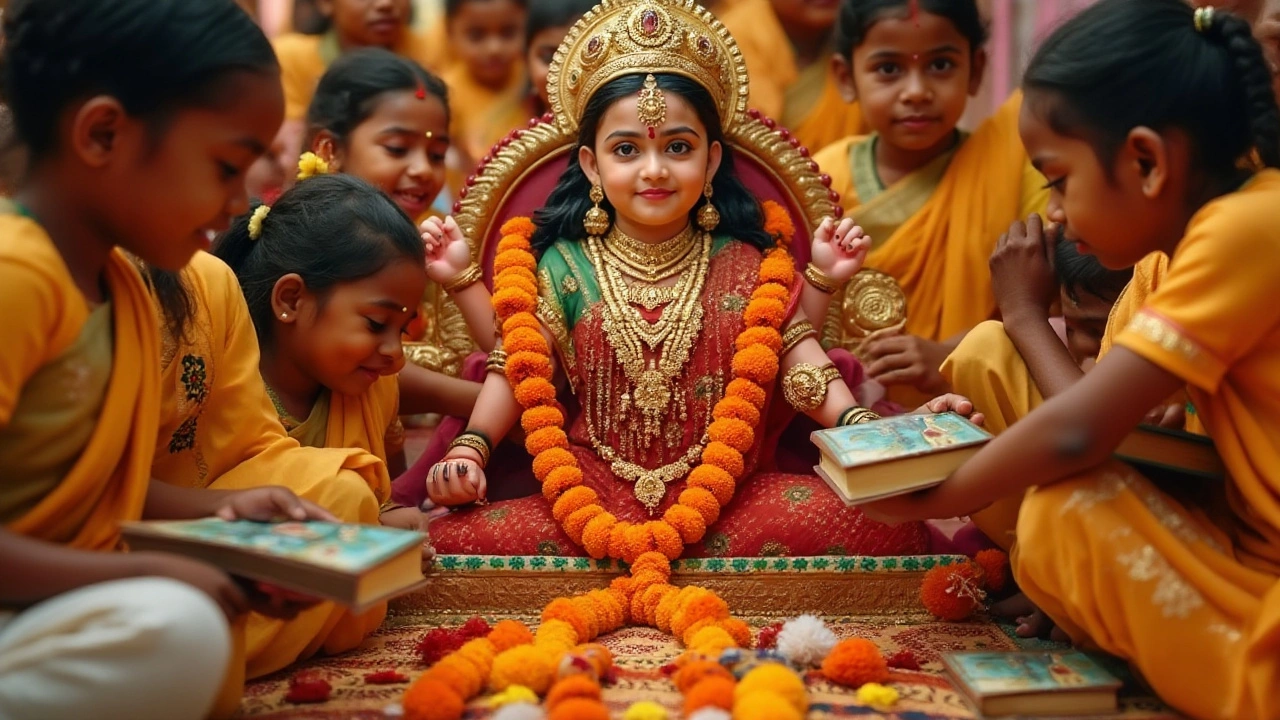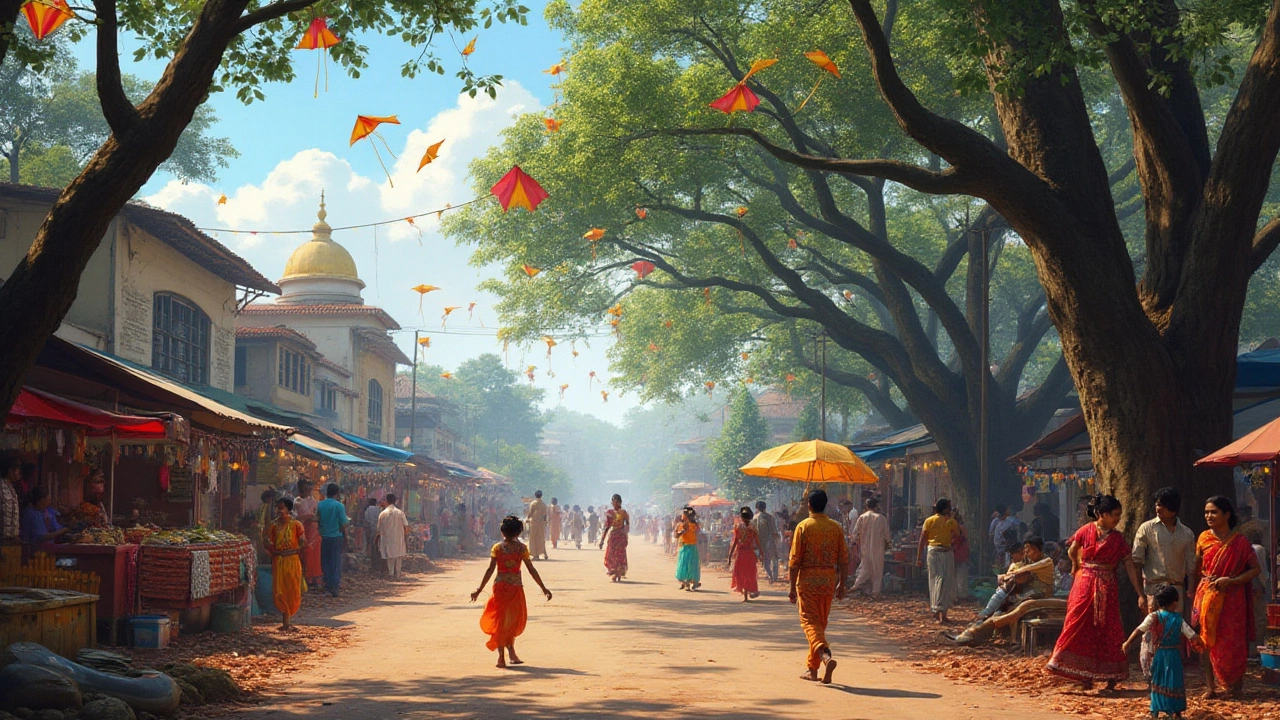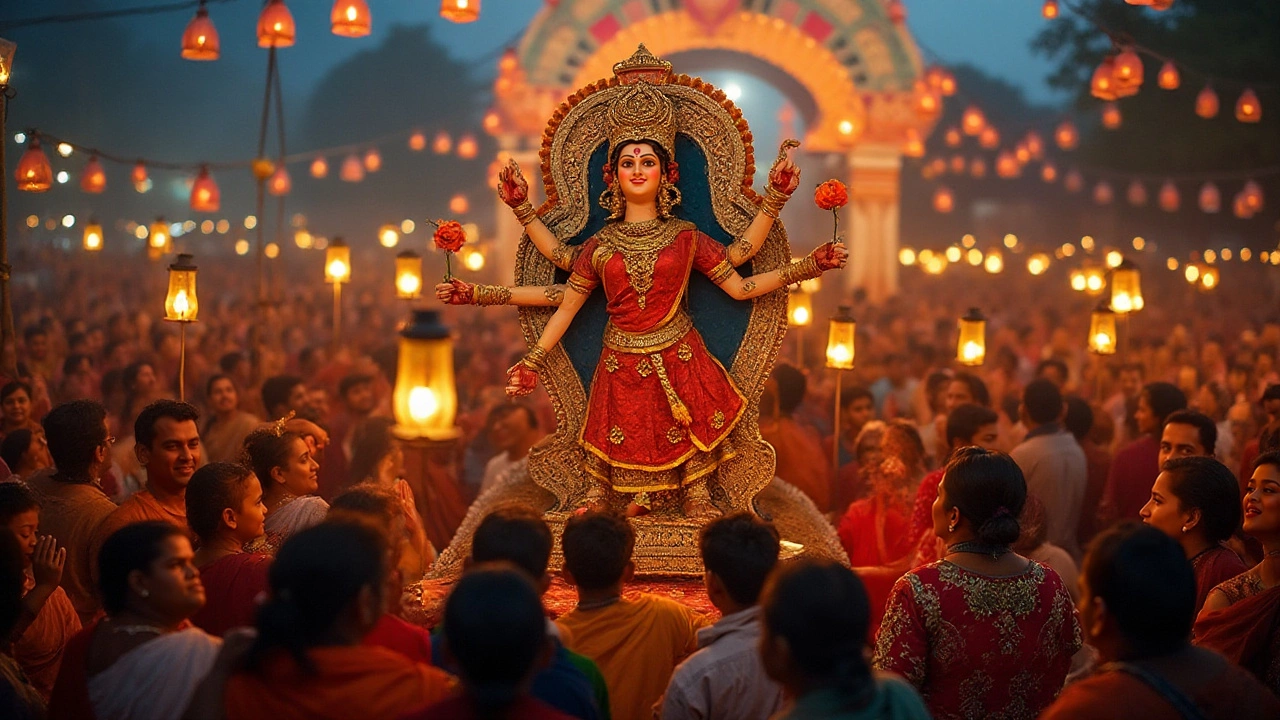Bengali culture stands as a kaleidoscope of traditions, refinement, and festivities that offer a unique glimpse into the rich tapestry of life in West Bengal and Bangladesh. The joy and enthusiasm for celebrating festivals are deeply embedded in a Bengali soul, transcending regional and international boundaries. From the intricate rituals of Durga Puja to the simplicity of Naboborsho, each celebration carries its own charm and historical significance.
As we delve into these fascinating gatherings, we uncover the customs, rituals, and communal feelings that bring Bengali people together, not just in India, but across continents. Interestingly, the essence of these festivals has found its place in countries with vibrant Bengali communities. These festivals not only foster a sense of belonging but also serve as a reminder of the cultural roots and shared heritage of Bengalis worldwide.
- Understanding the Vibrancy of Bengali Festivals
- Durga Puja: The Grand Celebration
- Poetry and Learning in Saraswati Puja
- Harvest and New Year Celebrations: Naboborsho and Poush Parbon
- The Global Bengali Influence: Festivals Beyond Borders
- Cultural Preservation and Evolution of Bengali Festivals
Understanding the Vibrancy of Bengali Festivals
The festivals that emerge from the heart of Bengal are a mesmerizing mix of colors, emotions, and historical significance. Nestled in the northeastern part of the Indian subcontinent, the Bengali region, comprising both West Bengal in India and Bangladesh, is renowned for an unyielding passion for celebrations. These Bengali festivals provide a window into the joie de vivre that defines this culture. The deep-rooted spiritual and sacred aspects of the festivals are intertwined with community-focused, joyous occasions that bring families and friends together, irrespective of their geographical locations. The omnipresent artistic expression, be it in craft, music, or dance, resonates with the spirit of each celebration.
One of the pivotal elements that set Bengali festivals apart is the elaborate preparation they entail. Communities begin months in advance, planning events that can last for days, urging people from all walks of life to participate wholeheartedly. Traditions passed down through generations find new life each year, with landmarks like the grand pandals of the Durga Puja becoming arenas of cultural display, creativity, and craftsmanship. These structures, often towering and intricate, attract hordes of visitors who are keen to witness the spectacle. The festivals thus become a tapestry of folklore and modernity, retaining their essence while adapting beautifully to contemporary lifestyles.
An intriguing aspect of Bengali festivals is the seamless blend of religious rites with cultural rituals. For instance, during the Durga Puja, you don't just witness prayers and offerings; you observe theatrical performances, gain culinary experiences, and contribute to meaningful charitable endeavors. This unique combination fosters a profound sense of unity and belonging among participants and observers alike. Often, the piety of the festival meets the vibrancy of life in Bengal, crafting an experience that is as festive on the streets as it is spiritually uplifting at the heart of the celebrations.
In upholding these traditions, the Bengali community worldwide exhibits a distinctive attribute of transposing cultural heritage onto foreign soil. During major festivals, Bengalis abroad resurrect the spirit of their homeland through vibrant processions and celebrations. The diaspora is known for holding extensive, meticulous recreation of native festivities that capture the essence of Bengal, its spicy cuisine mingling with melodious songs in immersive cultural spaces. It is in these gatherings, often in cities as far removed as London or New York, that the vibrancy of Bengali culture shines brilliantly even outside its native land.
"Bengali festivals are not just about celebrating; they are about bringing generations closer, entwining the old with new, and showcasing the ever-evolving nature of cultural pride." — Dr. Anjali Chakraborty, Cultural Anthropologist
Speaking of places beyond borders, the strength and preservation of Bengali cultural identity are truly remarkable. A pertinent example lies in the consensus among scholars of how these festivals preserve historical anecdotes, often through oral traditions, paintings, and traditional attire. This celebration of ethnic charisma is often seen as a way to preserve anthropological evidence, ever since the era of the Tagores and beyond. Consequently, it's more than just festivity. It is an alive chronicle of a thriving culture, celebrated diligently year after year, intertwining tradition with innovation.
Durga Puja: The Grand Celebration
Durga Puja stands as a vibrant testament to the rich tapestry of Bengali culture, celebrated with immense fervor across West Bengal and in Bengali communities worldwide. This auspicious festival, marking the victory of Goddess Durga over the buffalo demon Mahishasura, paints cities and villages in hues of joy, spirituality, and togetherness. The celebration goes beyond religious significance, embodying a socio-cultural phenomenon that brings together people from diverse backgrounds. What makes Durga Puja truly unique is its blend of art, culture, and devotion, transforming entire neighborhoods into galleries of creativity and devotion.
The preparation for the festivities begins months in advance as artisans meticulously craft clay idols of Goddess Durga. These idols, often featuring intricate details, grace the elaborately decorated pandals that pepper the cityscape. One cannot overlook the sheer scale of the event, with thousands of such pandals featuring thematic decors ranging from mythological scenes to contemporary issues. The grandeur of these installations captures the imagination of millions, drawing locals and tourists alike into their enchanting embrace. Within this splendid display, the sounds of dhak drums and the smells of traditional Bengali cuisine add to the sensory allure of the festival.
The heart of Durga Puja lies in its rituals and customs, which signify age-old traditions preserved through generations. The daily rituals, from the awakening of the Goddess to the immersion of the idols in the river, are performed with great devotion and precision by priests adorned in traditional attire. Although these customs hold deep religious meaning, they seamlessly incorporate modern influences, reflecting the dynamic nature of Bengali traditions. During these days of festivity, families reunite, indulge in shopping sprees, and participate in cultural programs that showcase traditional music, dance, and theater. An aura of camaraderie permeates the festivities, fostering a sense of community and belonging.
One cannot discuss Durga Puja without mentioning the 'Sindoor Khela', a unique ritual where married women playfully smear vermilion on each other, symbolizing the power and bliss of divine femininity. This ritual, often captured in countless photographs, epitomizes the festival's vibrant and joyous spirit. A Bengali saying goes, "Barite thaka pakaa sheychhe, tai Durga pujo mele haa mone bhabna," which translates to "When the household is filled with ripe harvest, that’s when the mind rejoices in Durga Puja." This not only emphasizes the cultural importance of the harvest season in Bengal but also ties the festival to its agricultural roots.
The global diaspora of Bengalis takes the essence of Durga Puja far beyond the geographical confines of Bengal. Cities around the world, from Kolkata to New York, resonate with the same zeal and devotion, adapting the festival to new cultural landscapes while preserving its core values. For many expatriates, these celebrations become an avenue to connect with their heritage and pass on cherished traditions to future generations. As one participant quoted in an international radio interview expressed,
"Durga Puja is not just a festival; it is our identity, a way for us to feel at home no matter where we are."Such testimonials highlight the enduring cultural significance of Durga Puja among Bengalis globally, evidencing its role as a cultural lifeline connecting communities across the world.

Poetry and Learning in Saraswati Puja
The festival of Saraswati Puja is a hallmark of the intellectual richness intrinsic to Bengali culture. Celebrated annually in the honor of Goddess Saraswati, the deity of learning, wisdom, music, and the arts, this festival embodies the pursuit of knowledge and culture. Observed on the fifth day of the Hindu month of Magha, it marks a period of solemn devotion and spirited celebration. This day, also called Vasant Panchami, resonates with educational undertones, as students offer books and instruments to the goddess, seeking her blessings for success in their academic and artistic endeavors.
The rituals involved are simple yet meaningful. Practitioners don yellow attire, which symbolizes the onset of spring and the colors of mustard fields in bloom. The ceremonies start with an invocation to the goddess, often including a combination of hymns, prayers, and carefully arranged offerings of fruits, sweets, and flowers laid around the idol. The act of placing textbooks and musical instruments near the idol signifies the unyielding respect for knowledge and creativity, reflecting a deep-seated tradition that transcends mere ritualism.
“May Goddess Saraswati, who is bedecked with pure white attire and seated on a white lotus, purify our lives.”
The celebration is not restricted to individuals. Educational institutions and cultural organizations engage actively in organizing elaborate functions. Schools and colleges observe holidays, turning their campuses into vibrant hubs of creative expressions where students showcase their talents through exhibitions, recitals, and debates. This collective celebration underlines Bengal's historical commitment to nurturing intellect and fostering a vibrant learning environment. In recent times, digital platforms have augmented these cultural exchanges, allowing diasporic communities to participate in communal observances, ensuring that heritage remains alive.
The appeal of Saraswati Puja stretches beyond religious ritualism into the heart of the scholarly tradition prominently esteemed in Bengali households. The festival inspires young minds to embrace knowledge earnestly, encouraging creativity while maintaining a balance with structured learning. While the day peaks with rituals, it often concludes with feastings, merging culinary art with cultural values, emphasizing familial solidarity and community bonding. Such comprehensive celebrations underscore the festival's capacity to bundle academic aspirations with spiritual grace.
Harvest and New Year Celebrations: Naboborsho and Poush Parbon
Nestled in the heart of Bengali culture are two distinct yet equally enchanting celebrations marking the end of the harvest and the advent of the new year. These festivals, known as Naboborsho and Poush Parbon, are rich in tradition, bringing communities together in a shared expression of joy and gratitude. Naboborsho, celebrated as the Bengali New Year, is a time honored not only in West Bengal and Bangladesh but also by the diaspora globally. Traditionally marked on the 14th or 15th of April, it serves as a fresh beginning, filled with hope and aspirations. Homes are decorated, sweet treats are made, and cultural performances add color to the day, symbolizing renewal and prosperity. Businesses open new accounts, marking 'Hal Khata', a ritual that signifies the beginning of new financial records.
Poush Parbon, on the other hand, heralds the harvest season, typically observed in January. As the winter solstice passes, the end of the harvest season is celebrated with much enthusiasm. Traditionally, the festival features 'Pithey'—a variety of rice cakes and sweets made from freshly harvested paddy, alongside jaggery and coconut. Families gather around to partake in cooking and sharing these delicious treats, celebrating the bounty nature has provided. The heartwarming aroma of 'payesh' cooked with date palm jaggery is enough to stir nostalgia among Bengalis near and far.
Both Naboborsho and Poush Parbon emphasize community spirit and cultural richness. These festivals are not just about rituals, but they offer a lens into Bengali life, where agriculture plays a crucial role. Through these celebrations, a shared identity and cultural preservation are ensured amid the ever-evolving world. In the words of Rabindranath Tagore, a Nobel laureate from Bengal,
'The world speaks to me in colors, my soul answers in music.'His words perfectly capture the essence of Bengali festivals like these, where vibrant colors of celebration and the harmonious music of traditional songs intertwine beautifully.

The Global Bengali Influence: Festivals Beyond Borders
As Bengali communities have spread across the globe, they have carried with them the vibrant tapestry of their Bengali festivals, enrichening the cultural landscapes of numerous countries. Large-scale celebrations of Durga Puja in places like London’s Camden, Toronto’s Nathan Phillips Square, and New York’s Jackson Heights exemplify how these festivals have not only been adapted but have thrived, bridging generations and knitting the global diaspora closer. In these venues, one can find artisans meticulously crafting idols, women in colorful sarees participating in rituals, and the air filled with the intoxicating aroma of traditional Bengali cuisine. These festivals are not merely cultural showcases but serve as a platform for instilling a sense of identity and nostalgia among younger Bengalis born overseas, connecting them back to their rich heritage.
In recent years, there has been a marked increase in the number of non-Bengalis participating in these festivities, drawn by the allure of the music, the cuisine, and the sheer atmosphere of camaraderie. It’s not uncommon to see people from different ethnic backgrounds taking part in the Bjaya Dashami procession, smearing sindoor and dancing joyously as the idols are immersed in rivers and lakes far away from the Hooghly or the Ganges, yet symbolizing the same spiritual devotion. A study by the Global Bengali Network found that as of 2023, Bengali festivals rank among the top 20 cultural events attended by non-Indians in the Western world, emphasizing their global influence and appeal.
The significance of such celebrations extends beyond just the festive days. They have brought about businesses specializing in Bengali cultural paraphernalia and cuisine catering to the increasing demand. Books by authors like Amitav Ghosh have also highlighted the tales of migration and cultural adaptation, echoing the words of anthropologist Dr. Arijit Das:
"Migration does not signify the end of a tradition, but rather its evolution."This evolving landscape has led to innovative ways of celebrating these traditions, with virtual pujas and online cultural exchanges becoming essential parts of modern festivities, enabling participation from every corner of the world. Thus, as Bengali festivals permeate international boundaries, they serve as poignant reminders of how culture can preserve and adapt, resonate and transform, in a global context.
Cultural Preservation and Evolution of Bengali Festivals
The vibrancy of Bengali festivals not only enlivens the culture but also ensures its endurance through centuries. One of the essential tenets of these festivals is their ability to adapt and thrive in changing environments while holding onto the core traditions. As Bengali communities have dispersed around the globe, their rituals and celebrations have also evolved, accommodating new influences and integrating diverse elements. This dynamic process is evident in how festivals like Durga Puja are now celebrated with digital broadcasts and community events worldwide, allowing for wider participation.
The evolution of these festivals demonstrates a stunning capacity for preserving essential cultural practices while embracing modernity. In Kolkata, for instance, Durga Puja pandals are artistic marvels, blending contemporary art with age-old iconography. Abroad, the festivals mirror a fusion of local cultures and Bengali traditions, resulting in unique celebrations. This adaptability not only ensures survival but also enriches the culture, making it appealing to younger generations who might otherwise drift away. A study conducted by the Kolkata Cultural Society noted that 75% of overseas Bengalis actively participate in maintaining traditional festivals, a testament to their enduring significance.
Interestingly, technology plays a pivotal role in keeping these traditions alive. Global connections facilitated by social media allow the diaspora to engage with these celebrations no matter their location, bridging geographical divides. In regions majorly occupied by Bengali communities, the adoption of hybrid festivals is prevalent. Here, the rich customs blend with local traditions, creating distinct festivals that honor the past while celebrating the future. An example can be seen in New York's annual 'Pohela Boishakh Parade,' which merges the love for vibrant street processions with Bengali New Year festivities.
The resilience of Bengali culture is embodied in every festival, a testament to a community that thrives in diversity and embraces change while honoring its roots.
Such adaptability has not gone unnoticed by cultural commentators. Many scholars argue that the preservation of Bengali festivals relies on this very evolution. By inviting new experiences into their celebrations, these festivals remain relevant and exciting for future generations. This adaptability can be seen as a testament to the strength and resilience of a culture that has managed to sustain itself through various historical transformations and geographic displacements. A unique feature of this evolution is the inclusivity exhibited by Bengali festivals. As they traverse global boundaries, they open their doors to a mix of traditions, gaining new followers along the way.
Preservation through Education and Community Initiatives
Community organizations play a crucial role in preserving and promoting these vibrant celebrations. Education initiatives conducted by cultural societies ensure that traditional Bengali art forms involved in festivals—be it dance, music, or crafts—are passed down from generation to generation. Workshops, cultural camps, and school programs are frequently held to inculcate a sense of pride and belonging among the youth. These activities ignite curiosity about traditions and equip them with the skills to partake meaningfully in the festivals.
The collaborative nature of these cultural preservation efforts brings together artisans, community leaders, and enthusiasts, all committed to keeping the essence of Bengali festivals alive. Events organized in different parts of the world by local Bengali associations not only highlight the vitality of the culture but also introduce it to a broader audience. Consequently, these efforts contribute significantly to the global recognition and appreciation of Bengali heritage, fostering a sense of shared cultural identity among the people who participate.
